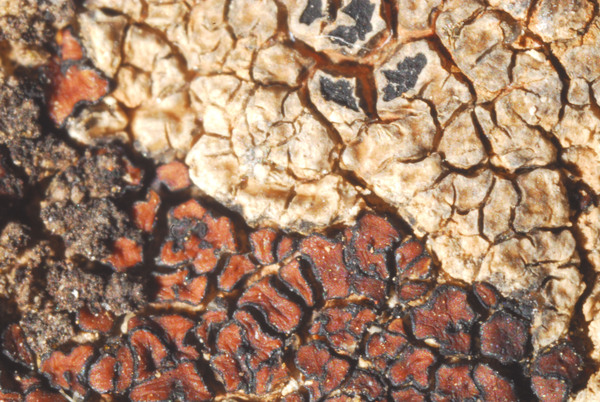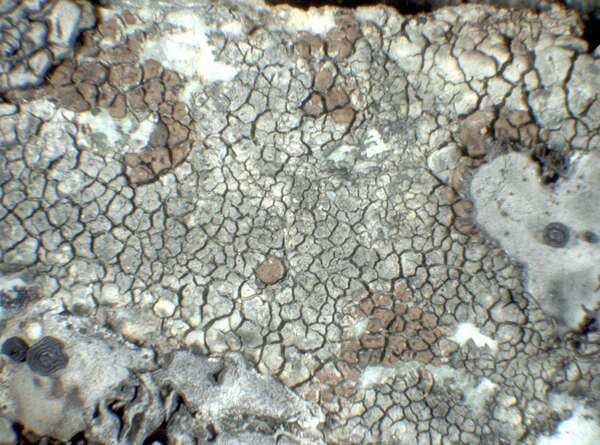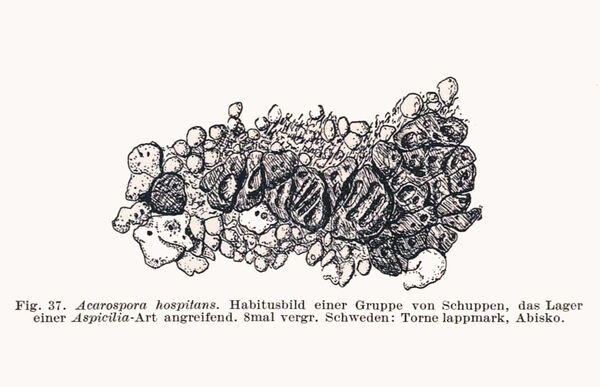Acarospora hospitans H. Magn.
Göteb. Vetensk.-och Vitter.-Handl., ser. 4, 28, 2: 111, 1924.
Synonyms: Acarospora impressula var. hospitans (H. Magn.) Clauzade & Cl. Roux
Description: Thallus crustose, episubstratic, chestnut brown to dark brown, areolate-subsquamulose, forming small islands or lines on the thalli of other crustose lichens, the areoles dispersed or contiguous, 0.3-1.5(-1.8) mm wide, smooth, usually slightly glossy, flat or moderately convex; lower side pale. Upper cortex (20-)30-40(-60) µm thick, brown in upper part, colourless in lower part, the cells 1.5-2.5 μm wide, overlain by a thin amorphous layer; algal layer regular, usually continuous; medulla white, inspersed with crystals. Apothecia lecanorine, of different shapes but most often elongate, 0.1-1.5 x 0.1-1.2 mm, immersed in the areoles, usually 2-5 per areole, with a brown, concave to flat disc, and a thin, sometimes poorly evident thalline margin. Proper exciple 15-20 µm thick; epithecium red-brown; hymenium colourless, (50-)75-90(-100) µm high, the hymenial gel euamyloid, IKI+ persistently dark blue; paraphyses 1.5-2 µm thick at base, the apical cells 3-3.5 µm wide; hypothecium colourless, c. 30 µm high. Asci c. 100-spored, clavate, the apical dome K/I-. Ascospores 1-celled, hyaline, broadly ellipsoid, 3-5 x 2-3 µm. Pycnidia immersed. Conidia ellipsoid, 1-2 x 0.7-1.5 µm. Photobiont chlorococcoid. Spot tests: cortex and medulla K-, C-, KC-, P-, UV-. Chemistry: without lichen substances.
Growth form: Crustose
Substrata: rocks
Photobiont: green algae other than Trentepohlia
Reproductive strategy: mainly sexual
paras Aspicilia spp.
Poorly known taxon in need of further study
Commonnes-rarity: (info)
Alpine belt: rare
Subalpine belt: rather rare
Montane belt: rare
Dry submediterranean belt: extremely rare
Humid submediterranean belt: extremely rare
Padanian area: absent
pH of the substrata:
1 2 3 4 5
Solar irradiation:
1 2 3 4 5
Aridity:
1 2 3 4 5
Eutrophication:
1 2 3 4 5
Poleotolerance:
0 1 2 3
Altitudinal distribution:
1 2 3 4 5 6
Rarity
absent
extremely rare
very rare
rare
rather rare
rather common
common
very common
extremely common
Loading data...
Occurrence data
Predictive map
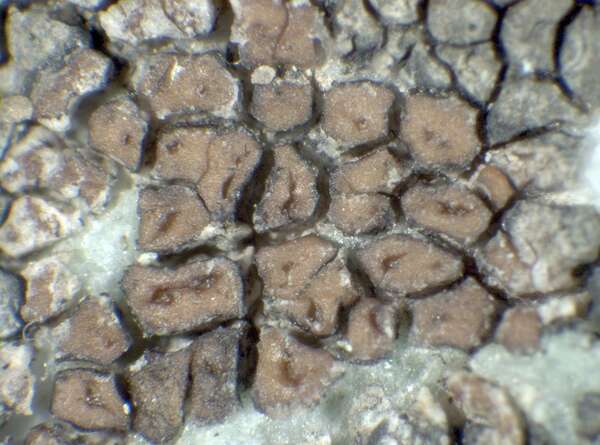
P.L. Nimis; Owner: Department of Life Sciences, University of Trieste
Herbarium: TSB (35208)
2002/07/09
on the host, Aspicilia sp.
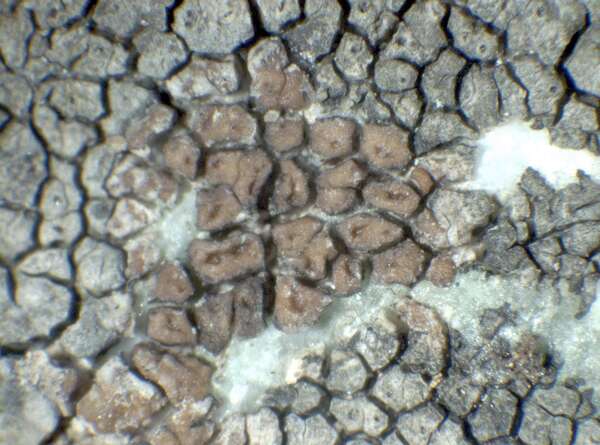
P.L. Nimis; Owner: Department of Life Sciences, University of Trieste
Herbarium: TSB (35208)
2002/07/09
on the host, Aspicilia sp.
Growth form: Crustose
Substrata: rocks
Photobiont: green algae other than Trentepohlia
Reproductive strategy: mainly sexual
paras Aspicilia spp.
Poorly known taxon in need of further study
Commonnes-rarity: (info)
Alpine belt: rare
Subalpine belt: rather rare
Montane belt: rare
Dry submediterranean belt: extremely rare
Humid submediterranean belt: extremely rare
Padanian area: absent
pH of the substrata:
| 1 | 2 | 3 | 4 | 5 |
Solar irradiation:
| 1 | 2 | 3 | 4 | 5 |
Aridity:
| 1 | 2 | 3 | 4 | 5 |
Eutrophication:
| 1 | 2 | 3 | 4 | 5 |
Poleotolerance:
| 0 | 1 | 2 | 3 |
Altitudinal distribution:
| 1 | 2 | 3 | 4 | 5 | 6 |
Rarity
absent
extremely rare
very rare
rare
rather rare
rather common
common
very common
extremely common
Loading data...
Occurrence data
Predictive map

P.L. Nimis; Owner: Department of Life Sciences, University of Trieste
Herbarium: TSB (35208)
2002/07/09
on the host, Aspicilia sp.



